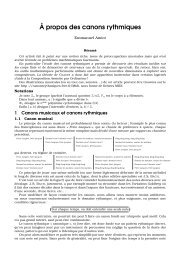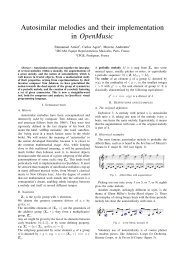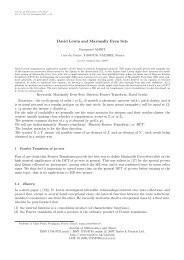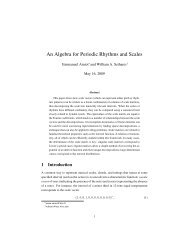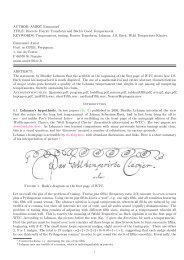Emmanuel Amiot Modèles algébriques et algorithmes pour la ...
Emmanuel Amiot Modèles algébriques et algorithmes pour la ...
Emmanuel Amiot Modèles algébriques et algorithmes pour la ...
Create successful ePaper yourself
Turn your PDF publications into a flip-book with our unique Google optimized e-Paper software.
Proof. I begin with pointing out that the map (k, j) ↦→ n × k − m × j is one-to-one (and onto) from Zm × Zn to<br />
Zn×m, where Zp stands for the cyclic group with p elements. This morphism (it is well defined, and obviously<br />
linear) of Z−modules is injective:<br />
n × k − m × j ≡ 0 (mod n m) ⇐⇒ ∃ℓ, n k = m j + ℓ × m n ⇐⇒ m | k and n | j<br />
⇐⇒ k ≡ 0 (mod m) and j ≡ 0 (mod n)<br />
using Gauss’s lemma (m divides n k but is coprime with n, hence divides k, simi<strong>la</strong>rly for n); and hence bijective<br />
because the cardinalities of both domain and codomain are finite and equal.<br />
This enables to choose n couples (k0, 0), (k1, 1) . . . (kn−1, n − 1) in Zm × Zn with n kj − m j ∈ {0, 1, . . . n − 1}<br />
(mod m) × n, (choosing j first then kj) hence kj j<br />
n − 1 1<br />
− stays b<strong>et</strong>ween 0 and <<br />
m n n m m .<br />
Hence the vectors occuring in the computation of FA(1), i.e. the e2iπ( kj j<br />
− m n ) , are as close tog<strong>et</strong>her as possible.<br />
This maximizes their sum, as the cosines of their projections on the direction of their sum g<strong>et</strong> as close to 1 as<br />
possible. This is proved by the following ‘huddling lemma’, whose general form may be found in [1].<br />
Lemma 2. L<strong>et</strong> e2ikjπ/m <br />
<br />
, i = 1 . . . n be n different mth <br />
roots of unity. Their sum has length at most e<br />
1≤k≤n<br />
2ikπ/m<br />
<br />
<br />
<br />
<br />
<br />
i.e. the maximum value is obtained when all these points are huddled tog<strong>et</strong>her.<br />
Figure 7. The sum increases when the points are closer<br />
Proof. Put S = e 2ikjπ/m . Then |S| ≥ Re S = cos(2kjπ/m). Say for instance that n is odd: then there<br />
are exactly n integers b<strong>et</strong>ween<br />
1 − n<br />
2<br />
and<br />
n − 1<br />
.<br />
2<br />
(n − 1)<br />
Unless the kj are precisely these integers, there exists some j0 with |kj0 | ><br />
that is not one of the kj. As<br />
2<br />
and a value k ′ ∈ [<br />
1 − n<br />
,<br />
2<br />
n − 1<br />
11<br />
]<br />
2<br />
cos(2πkj0π/m) < cos(2πk′ π/m),<br />
the sum of cosines is increased when k ′ is substituted to kj0 . This can be done till all the kj’s<br />
1 − n<br />
are in [ ,<br />
2<br />
n − 1<br />
],<br />
2<br />
and as there are n such kj’s, they must be the n consecutive integers lying in this range. Then Re S is at<br />
<strong>la</strong>st maximal, and so is |S| = Re S (this <strong>la</strong>st equality is now true by symm<strong>et</strong>ry). The case ‘n even’ is a little<br />
trickier but simi<strong>la</strong>r and will be left to the reader, as this paper only needs a proof when n = 7, m = 12. <br />
We r<strong>et</strong>urn to the proof of the theorem. The lemma proves that the maximum configuration occurs when<br />
Multiplying by f = n −1 mod m yields<br />
A = {k0, . . . kn−1} with {n kj − m j} = {0, 1, . . . n − 1}<br />
{kj} =<br />
mod m {kj − f × m × j} = {0, f, . . . (n − 1)f}




